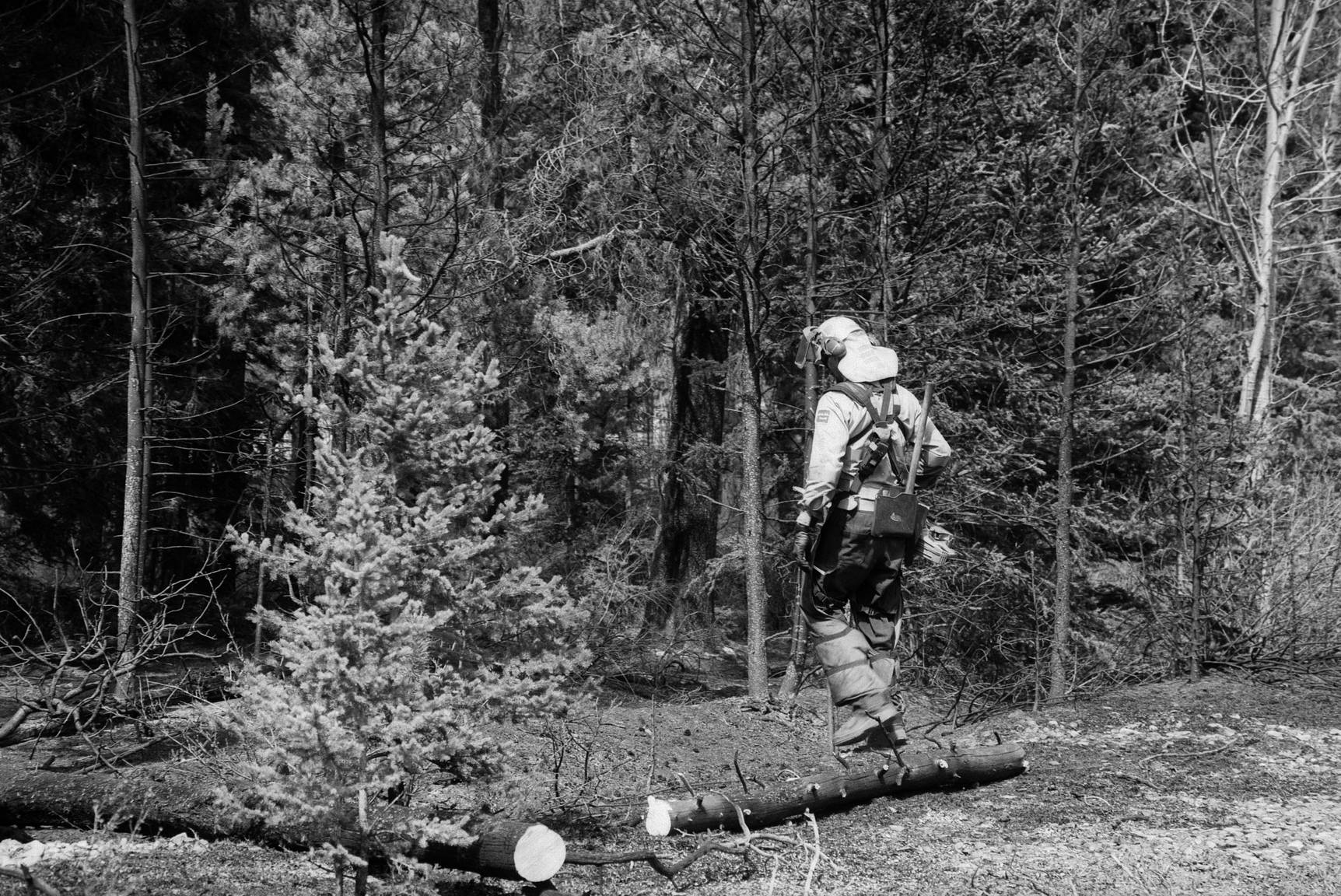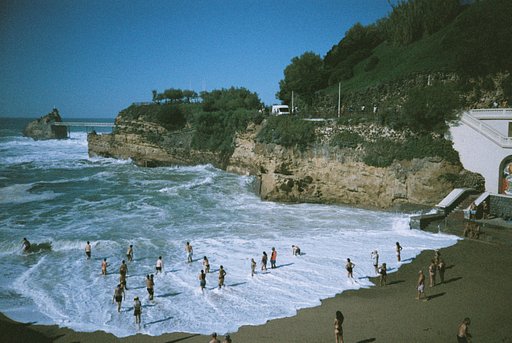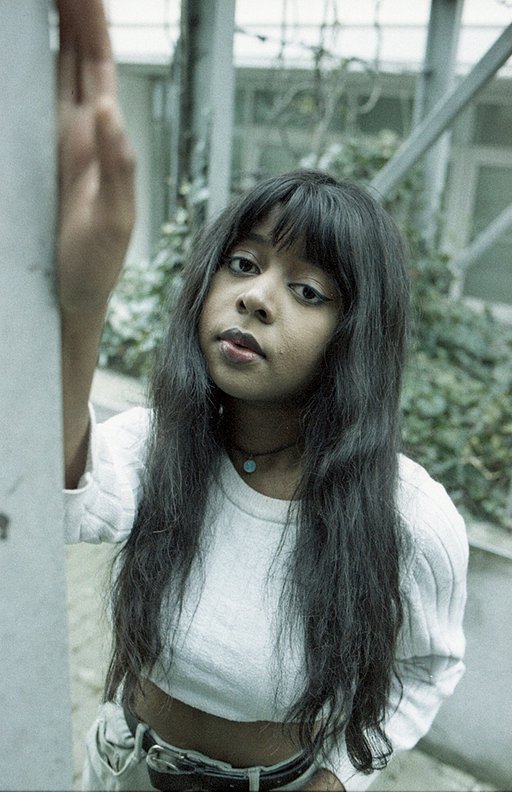Graeme Loerke's "Fire in Film" Documents the Frontlines of Fighting Wildfires in Canada
5 Share TweetGraeme Loerke is a wildland firefighter based in Alberta, Canada who has been working on the frontlines of wildfires for the past nine years. Starting his analogue photography journey in 2020, his current ongoing project Fire in Film documents and spreads awareness about the work of firefighting teams to suppress these devastating fires.
By shooting his documentations on black and white film, Graeme uses the timeless aesthetic to emphasize how the job for those on the fireline hasn't changed much within the past half century.
This past summer he shot some of the project on our Earl Grey B&W 35mm film during a women in fire specific training exercise.
Hi Graeme, welcome to Lomography Magazine! Can you tell us about yourself and your work in general?
Hi Lomo, my name is Graeme Loerke. I am a 28-year-old Canadian from the province of Alberta. I started my photography journey with digital photography in 2014. At this time my main interests were night sky, and landscapes.
In 2015 I enrolled in a forestry degree program at the University of Alberta. This is where I found a love of wildlife, and especially bird photography. It is through the University of Alberta that I also discovered what would soon be one of my main passions, wildfire.
In 2016 I began my wildfire career, as a Helitack crew member for the province of Alberta, in the far north of the province. I have been in wildfire ever since, moving from Alberta to Parks Canada.
Can you tell us about your work for your series Fire in Film?
My series Fire in Film is an attempt to tell the story of wildland firefighting through film photography.
Wildfire is a practice that hasn't changed much since the time we began to control wildfires. Photos taken in the 1950s of wildfire operations look much the same today when black and white film is the medium for recording these photos. This gives the film a timeless look, and helps tell the story of wildfire, and its slow change over time.
What was your background in analogue photography before starting the series?
In 2020 during the start of Covid my crew leader at the time was a film photographer, and he encouraged me to bring a film camera up north with me, as something to learn to help pass some of the time isolated that summer.
I found my Grandpa’s old Minolta SRT101 in the basement of my parents house, and brought it up north with me, not realizing the passion for analogue photography it would fuel.
So, my analogue photography journey started with wildfire, although it took me a couple years before I felt comfortable bringing my Grandpa’s old film camera on the fireline with me.
Can you tell us about these photos shot with the Earl Grey B&W 35mm film ?
When I discovered film photography, I was amazed by the selection of film available, especially black and white films. I felt like each time I discovered a new film, I discovered a whole new sensor for my camera. It was an exciting time, every time I would order film online, there were at least three or four different film stocks in the cart for me to try out.
It wasn't long before Earl Gray was in my cart, and then in my camera on the fireline. My main camera body that I found myself shooting Earl Grey with on the fireline became a Canon AE1. I was lucky enough to find one of these gems at a thrift store for a reasonable price, and as you may be able to imagine, I was quite nervous to take my Grandpa's old camera on the fireline with me.
I chose the Canon AE1 not just because I found one at a great price, but also due to the tactile, analogue nature of shooting with the camera. I was looking for a camera that would slow me down, and force me to focus on the photography, even in the fast moving dynamic fire environment.
There is a saying in wildfire that we use a lot when things get hectic, that is, take a tactical pause. This means even when things are moving quickly, and need fast reactions, it is sometimes best to pause and think for a moment. Having an older manual focus, manual exposure film camera, helped me find this tactical pause in my photography. Instead of being able to snap off a dozen digital photos, auto focused, and perfectly exposed without much thought, I was forced to slow down, and enjoy the moments I found myself in, and take more meaningful photos.
How did the Earl Grey film compliment your vision for Fire in Film?
Earl Grey is a great film to shoot wildfire with. The wide tonal range, and fine grain works well with daytime fire environments, where you often find yourself in a dark forest, looking towards bright flames, or into a blue sky.
The deep blacks, and bright whites that are rendered with Earl Grey really help bring life photos of the fire environment.
ISO 100 is a really nice speed to have handy when on wildfires, as often I will try to shoot more open to bring a modern amount of background blur to portraits. I also find that for wildfire, shooting in daylight, I never lack light. Most of the work is done during the mid day hours, where having a 100 speed film is an asset.
I will also always remember the first time that I took Earl Grey out of the developing tank. I was immediately struck by how beautiful the negatives looked, on the characteristic clear base. I have since started to DSLR scan my film, and have also noticed that the clear base seems to make processing the negatives easier, while still maintaining an extremely fine grain.
What kind of gear do you use for shooting while living and working with a fire crew?
I find myself shooting a wide variety of cameras while living and working on a fire crew. My main shooter is the Canon AE1, but I also have picked up a Canon Elan 2E for use with my DSLR lenses, and for when I don't have the time to manually focus and adjust exposure. While being forced to slow down in photography is one of the big allures to going analogue for me, I still find myself occasionally wanting to move more quickly, when the action speeds up, or to help capture more candid moments, especially with portraits of crew members.
I commonly will bring a Minolta Hi Matic E on the fireline with me, as it is compact, and it brings me back to my original connection of shooting film with my Grandpa’s old camera.
The main challenge is keeping dust and soot out of my gear. To do this, any camera or lens that comes with me on the fireline is accompanied by its own individual dry bag, and is in this dry bag, even when in my little padded camera case.
Why is it important to you to document your work suppressing wildfires on film?
It is important to document wildfire suppression on film, as it highlights the timeless nature of wildfire work. Photos taken of fire crews today look almost identical when shot on black and white film, to photos taken in between the 50s and 80s. It helps to highlight a struggle to control nature that forest managers have been playing with since big fires broke out in the early 1900s. This is a struggle to control nature that we are coming up against again now, as exclusion of fire from our landscape has caused greater difficulty in managing fire today. We are facing the same problems trying to control fire today as we were in the 1900s, and I feel that when I am taking photos of fire on black and white film, I am reminded of this.
In the last couple years I have also been glad to have started my project documenting wildfire before the onslaught of AI generated images. I think as AI produces more and more realistic images, we will see a return to film, to remind us what is real.
Film negatives offer a record for historical moments, in an unalterable way that digital is unable to achieve. Not only are negatives a true record of events, but the scanned photos from the film offer a true, unedited version of our reality on the fireline. I think that it is important in an era of highly manipulatable media, to record events in a way that we can look back to with confidence that they portray the life of a wildland firefighter accurately.

Do you have a favorite shot from your roll of Earl Grey film? Is there a story behind it?
One of my favorite captures of wildfire that I got on my Earl Grey Film, is of a sawyer on a steep hill, working the Kindersley Fire in Kootenay Park this year. It shows the day-to-day work of wildland firefighting. Here we are removing dangerous trees that may fall on us from the fireline, in order to protect ourselves. We are also cutting a fuel-free line around the fire. This is the back breaking work of removing all fuels between the fires edge, and the surrounding forest. This is done every day on the fireline, and is how the majority of fires are put out.
Without fuel, it is impossible for the fire to continue to burn. Here in the north, we also follow up with water behind the fuel free, as our soils are deep and organic, it is common to have roots continue to burn under the mineral soil, and cause fire to pop up on the wrong side of the line. This photo was taken days into trying to control this wildfire, and as it shows the hills we were working on were steep, 50º in places. Carrying in chainsaws, fuel, drinking water, and hiking up and down these hills for 10 plus hours a day had us exhausted, yet there was still more fireline to cut.
This photo was taken as the heat of the day increased the smoke on the line. As the danger tree fallers work ahead of the water, we get little reprieve from the smoke, and you can see it lingering around the ground, as felling cuts are made in another danger tree. This fire was notable for me as one of the steepest fires I have ever worked, and this photo in particular brings me back to the struggle our crew had on this hill.
Where do you see yourself and the project going from here?
I would like to continue to shoot film on wildfires as my fire career continues. I would like to keep with the analogue nature of the film, and produce a photo book with images shot on film. I think the tactile nature of a book coincides well with the tangible nature of film. Like a negative is something to hold, and enjoy in person, I think a photo book might help bring the viewer a similar perspective that I have when negatives first come out of the tank!
I would like to see a greater audience get to experience my work. Wildfires are starting to impact us more and more in the north west, and giving people a human connection to the firefighters that work tirelessly to try and bring control to these fires is important. It is hard to describe what it is like to be on a wildfire, you can describe the smell of the smoke, and the exhaustion you feel after putting in a 16 hour day for 18 days in a row, but it is impossible to share with people how you feel, what it's like to be part of a crew, the humour, the joy in the labour, the highs and the lows. I hope that these powerful emotions can be shared through a tangible medium like film, and photo books.

Anything else you'd like to share?
I would like to take a moment to thank some of my mentors in wildfire. My first crew leader helped turn me from an immature 18 year old, into the person I am today. My crew leader in 2020 that helped me discover film, and my parents who have supported me through my university years. I would have never made it to university without them, and I would have never discovered wildfire without the forestry program at the U of A. I also have a very supportive wife, who may roll her eyes every time I try to tell her that I need more film, or a different lens, but who supports me and my ambitions nonetheless. I think we both are aware that my film photography habit will never pay any bills, but she shares my vision of telling the story of wildfire with this unique medium.
If you would like to follow along with me in this adventure, you can follow me on instagram @wildfireinfilm, or on my portfolio which is linked in the instagram bio.
If you're interested in keeping up with Graeme and his work, make sure to check out his Instagram and website.
written by eloffreno on 2024-03-13 #gear #people #places #nature #landscape #documentary #wild-life #wildfires

























No Comments